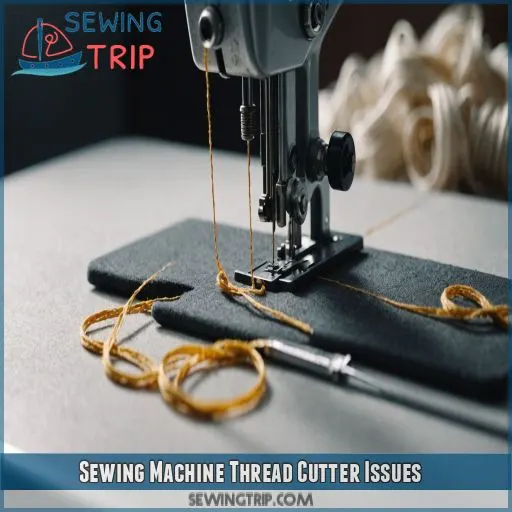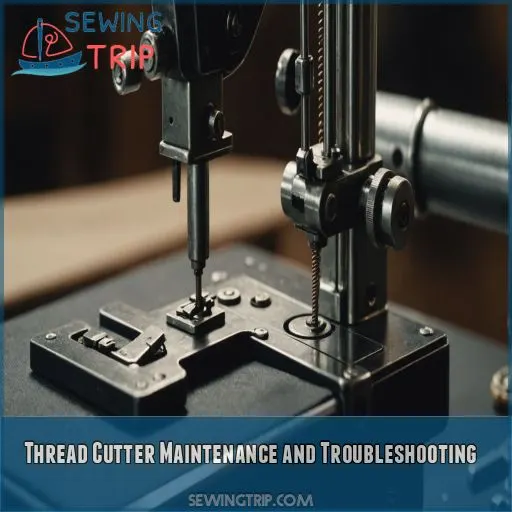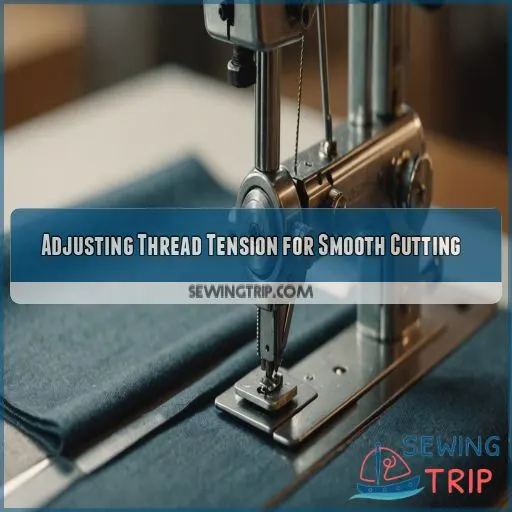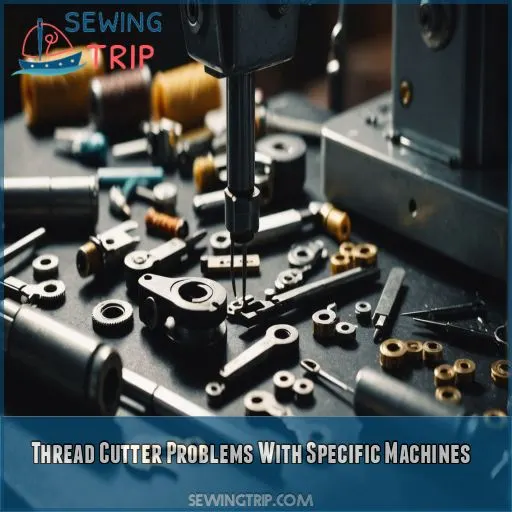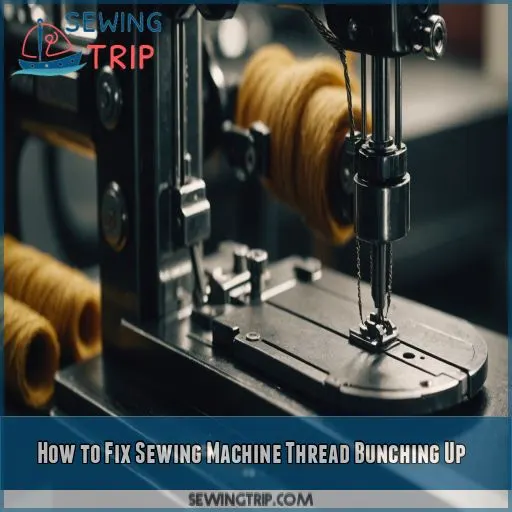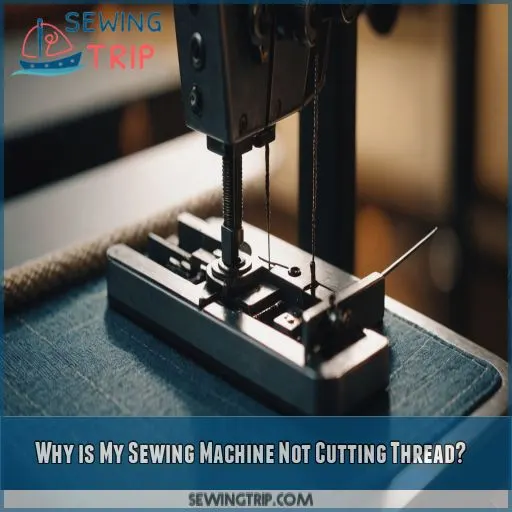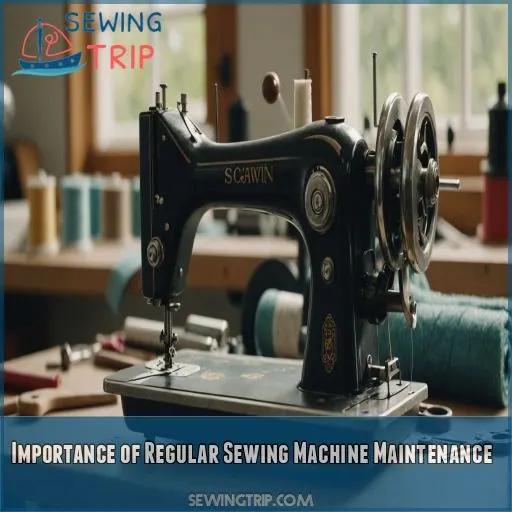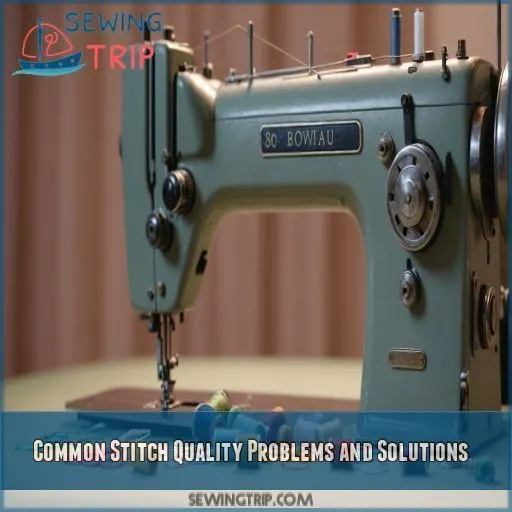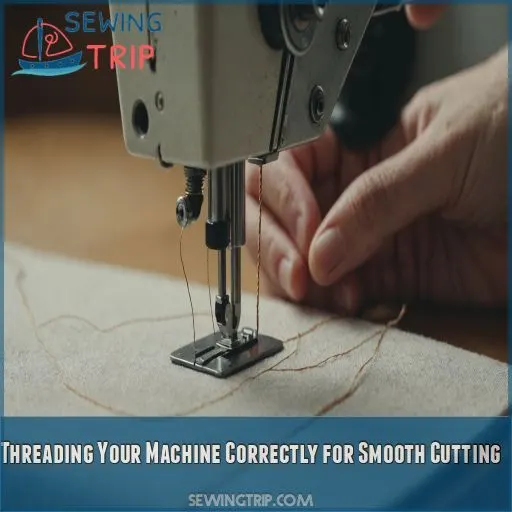This site is supported by our readers. We may earn a commission, at no cost to you, if you purchase through links.
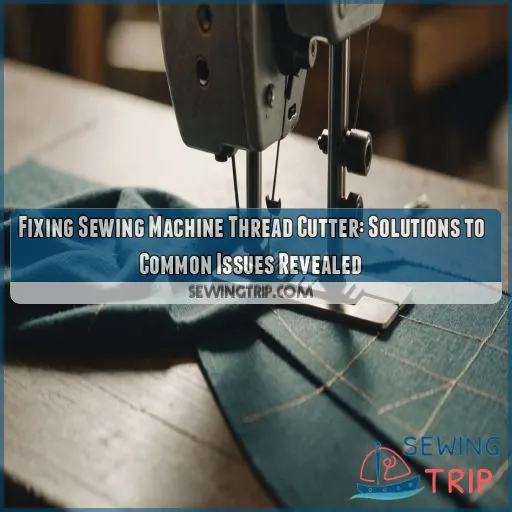 The frustration of a malfunctioning thread cutter! Don’t worry, you’re about to take back control of your sewing projects.
The frustration of a malfunctioning thread cutter! Don’t worry, you’re about to take back control of your sewing projects.
Fixing your sewing machine’s thread cutter is easier than you think. Start by identifying the issue – is it making strange noises, jamming threads, or just not working?
Cleaning and oiling the thread cutter can often resolve the problem. If not, it might be a Thread Tension issue. Adjusting the tension can make all the difference.
You’ll be smoothly cutting threads in no time. But, there’s more to mastering your thread cutter than just these quick fixes…
Table Of Contents
- Key Takeaways
- Sewing Machine Thread Cutter Issues
- Thread Cutter Maintenance and Troubleshooting
- Adjusting Thread Tension for Smooth Cutting
- Thread Cutter Problems With Specific Machines
- How to Fix Sewing Machine Thread Bunching Up
- Why is My Sewing Machine Not Cutting Thread?
- Importance of Regular Sewing Machine Maintenance
- Common Stitch Quality Problems and Solutions
- Threading Your Machine Correctly for Smooth Cutting
- Frequently Asked Questions (FAQs)
- Conclusion
Key Takeaways
- You’re not alone in your thread cutter struggles – and fixing it is easier than you think! Start by identifying the issue, whether it’s strange noises, jamming threads, or it’s just not working, and then try cleaning and oiling the thread cutter to resolve the problem.
- Mastering thread tension is key to smooth cutting, so take the time to adjust the tension dials and find the sweet spot for your machine and fabric – your threads (and sanity) will thank you!
- Regular maintenance is crucial to preventing thread cutter issues, so schedule that annual service and make sure to clean the thread catcher, oil the machine, and check for lint buildup to keep your machine running smoothly.
- Don’t be afraid to call in the experts if troubleshooting doesn’t resolve your thread cutter issues – reach out to your sewing machine’s support team or consult with a verified expert for personalized guidance and get back to sewing like a pro!
Sewing Machine Thread Cutter Issues
You’re probably here because your sewing machine’s thread cutter has stopped working, and you’re at your wit’s end. Don’t worry, you’re not alone – we’ll help you figure out some common issues and solutions to get your thread cutter up and running smoothly again.
Common Problems and Symptoms
You’re struggling with your sewing machine’s thread cutter – don’t worry, you’re not alone!
Common problems include strange noises, jammed threads, or the cutter simply not working.
Fabric bunching can also be a sign of thread cutter issues.
Check for lint buildup, broken threads, and improper thread tension to diagnose the problem.
Cleaning and oiling the thread cutter may be the solution you need.
Machine-Specific Thread Cutter Issues
Regarding machine-specific thread cutter issues, you’re not alone. Here are three common culprits:
- Janome HD9 issues: thread retracts out of the needle after cutting.
- Brother ULT2002D: auto thread cutter cuts bobbin thread too short.
- Bernina 770QE: main drive shaft failure can cause thread cutter problems. Knowing your machine’s quirks is key to fixing sewing machine thread cutter issues.
How to Identify Thread Cutter Problems
Now that we’ve explored machine-specific thread cutter issues, let’s get to the bottom of identifying thread cutter problems. Here’s a handy table to help you troubleshoot:
| Symptom | Possible Cause |
|---|---|
| Strange noises | Cutter blade condition, thread tension impact |
| Inconsistent cutting | Fabric type effect, thread cutter wear |
| Poor stitch quality | Thread tension, thread type, or machine calibration |
Check these common culprits to resolve your thread cutter woes!
Thread Cutter Maintenance and Troubleshooting
You’re about to become best friends with your sewing machine’s thread cutter – and by best friends, I mean you’ll learn how to fix it when it breaks. In this section, we’ll walk you through the essential maintenance and troubleshooting steps to keep your thread cutter running smoothly, from cleaning the thread catcher to servicing your sewing machine annually.
Cleaning the Thread Catcher and Removing Lint
Ever wondered why your thread cutter‘s not working? Let’s take a closer look at some cleaning tips! To get your thread catcher in tip-top shape, try these steps:
- Blast out lint with an air compressor
- Use a soft brush to gently sweep away debris
- Remove any visible blockages
- Clean the thread catcher with a mild detergent
- Regularly wipe down the area to prevent lint buildup
Servicing the Sewing Machine Annually
Servicing your sewing machine annually is like giving it a spa day – it keeps it running smoothly and prevents costly repairs. A regular maintenance schedule helps identify and fix issues before they become major problems. By doing so, you’ll save money in the long run and make sure your thread cutter works flawlessly. Schedule that service today!
Proper Lubrication and Fine-Tuning
Your trusty sewing machine’s thread cutter is acting up, and you’re ready to get it back in action. Proper lubrication and fine-tuning are key to keeping it running smoothly. Here are some tips to get you started:
- Check your sewing machine’s manual for a recommended lubrication schedule
- Use high-quality sewing machine oil to keep parts moving freely
- Experiment with different oil types to find what works best for your machine
- Fine-tune your thread cutter by adjusting the tension and alignment for a precise cut
Using an Air Compressor to Blast Out Lint
Using an air compressor to blast out lint is a game-changer for sewing machine maintenance. But, before you get started, make sure you’re using it safely.
| Safety Precautions | Lint Removal Tips |
|---|---|
| Wear protective eyewear | Use a small nozzle to target lint |
| Keep loose clothing tied back | Hold the compressor at a 45-degree angle |
| Avoid over-pressurizing the machine | Move the nozzle slowly and steadily |
Adjusting Thread Tension for Smooth Cutting
You’re on a roll with troubleshooting your sewing machine’s thread cutter, and now it’s time to tackle thread tension – the secret to smooth cutting. By adjusting your thread tension, you can prevent those pesky thread bunches and make sure your machine is working in harmony with your fabric and thread.
How to Adjust Thread Tension
Let’s get down to business – adjusting thread tension is key to smooth cutting.
First, locate the tension dials on your machine. They are usually easily accessible and will have clear markings to indicate the direction of adjustment.
Turn the tension dials clockwise to tighten or counterclockwise to loosen. This will allow you to make fine adjustments to the thread tension.
Consider the thread type when adjusting the tension. Different threads have different requirements, so it’s essential to take this into account.
Use a tension gauge to find the sweet spot. This will give you a more accurate reading than relying on guesswork.
For most threads, a medium to low tension setting works best. However, this can vary depending on the specific thread and machine you are using.
Experiment to find your ideal setting. It may take some trial and error, but it’s worth it to achieve smooth cutting.
Importance of Thread Tension for Thread Cutter
You’re on a roll, tackling that thread cutter issue like a pro! Now, let’s explore the importance of thread tension for a smooth-cutting experience. Here are the key factors:
- Thread Tension Impact: too loose, and threads tangle; too tight, and threads break.
- Thread Cutter Accuracy relies on the right tension.
- Proper Tension Setting prevents thread breakage.
- Cutter Performance Factors include thread type, fabric, and machine speed.
Tips for Thread Tension Adjustment
Now that you know the importance of thread tension for your thread cutter, let’s get down to business. To adjust thread tension, start by consulting your sewing machine’s user manual for specific guidelines. Here’s a quick reference table to get you started:
| Thread Tension Setting | Fabric Type |
|---|---|
| Low (2-3) | Delicate, silk, or cotton fabrics |
| Medium (4-5) | General sewing, polyester, or blends |
| High (6-7) | Thick, denim, or heavy-duty fabrics |
Thread Cutter Problems With Specific Machines
If your sewing machine’s thread cutter is malfunctioning, you’re not alone – many popular models, including the Janome HD9 Version 2, Brother ULT2002D, and Bernina 770QE, have their own set of thread cutter issues. Let’s tackle these machine-specific problems head-on and explore some practical solutions to get your thread cutter working smoothly again.
Janome HD9 Version 2 Thread Cutter Issues
Having trouble with your Janome HD9 Version 2 thread cutter? Don’t worry, you’re not alone! If your thread retracts out of the needle each time you use the thread cutter, it’s time to troubleshoot. Here are some potential causes:
- Incorrect thread tension (yep, it’s a thing!)
- Lint buildup in the thread cutter
- Worn-out or damaged thread cutter parts
- Misaligned or loose thread cutter mechanism
Brother Sewing Machine Model ULT2002D Thread Cutter Issues
The frustration of a malfunctioning thread cutter! If you’re a Brother ULT2002D owner, you might be experiencing auto thread cutter issues, where the bobbin thread is cut too short during embroidery. To resolve this, try adjusting the auto cutter settings or re-threading the machine. Regular maintenance is also key to preventing thread cutter failure and ensuring smooth embroidery.
Bernina 770QE Thread Cutter Problems
Are you wrestling with your Bernina 770QE’s thread cutter? Don’t worry, help is at hand! Issues often stem from the main drive shaft failing. Regular maintenance is key, so make sure to service your machine annually. Adjusting thread tension and fine-tuning can also resolve problems. Check for blockages and clean the thread catcher for smooth cutting.
How to Fix Sewing Machine Thread Bunching Up
You’re in the middle of a sewing project and suddenly, your thread starts bunching up – it’s frustrating, to say the least! Let’s get your thread flowing smoothly again by identifying the causes and exploring some practical solutions to fix sewing machine thread bunching up.
Causes of Thread Bunching Up
Don’t worry, friend, you’re not alone. The pesky thread bunching up issue is a common frustration.
This problem can be caused by a few different things.
Thread tension issues, bobbin thread problems, or fabric feed errors can all contribute to bunching.
Even thread quality matters, as low-quality threads can lead to bunching.
Additionally, sewing speed can also contribute to this issue.
Take a deep breath and let’s get into the causes!
Solutions for Thread Bunching Up
Thread bunching can be a real pain! Don’t worry, we’ve got solutions.
First, adjust your thread tension to match your fabric type and needle size.
Next, tweak your bobbin tension to make sure it feeds smoothly.
Check your stitch length, too – shorter stitches can cause bunching.
Tips for Preventing Thread Bunching Up
Ever get those annoying thread bunches while sewing? It’s a real pain!
To prevent thread bunching, keep your sewing machine‘s thread tension in check.
Adjust the tension according to the fabric type and thread quality.
Use the right needle size and make sure you wind the bobbin properly.
Also, regularly clean your machine and use high-quality threads to avoid tangles.
Why is My Sewing Machine Not Cutting Thread?
You’re frustrated because your sewing machine’s thread cutter has stopped working, and you’re stuck with a tangled mess. Don’t worry, we’ll help you out – in this section, we’ll walk you through the possible reasons why your thread isn’t cutting and provide step-by-step troubleshooting tips to get your machine up and running smoothly again.
Possible Reasons for Thread Not Cutting
Having trouble with your sewing machine’s thread cutter? Don’t worry, you’re not alone. Let’s explore possible reasons why your thread isn’t cutting:
- Lint buildup: Is lint clogging your machine?
- Incorrect thread tension: Are your threads too tight or too loose?
- Wrong needle type: Is your needle suitable for your fabric and thread?
- Poor thread quality: Are you using low-quality threads?
How to Resolve Thread Not Cutting Issues
To resolve thread not cutting issues, start by checking the thread cutter for lint buildup or debris. Clean the area thoroughly and oil the machine. Next, adjust the thread tension to a lower setting. If the issue persists, try using an air compressor to blast out any remaining lint. Regular maintenance is key to preventing cutting issues.
Troubleshooting Steps for Thread Not Cutting
Your sewing machine’s thread cutter has stopped working, and you’re left wondering why. Don’t worry, friend, we’re here to help! Let’s troubleshoot together. Here are some steps to get your thread cutter back in action:
- Check for lint buildup and clean the thread catcher
- Maintain proper thread tension
- Inspect the bobbin thread for tangles or knots
- Lubricate the machine’s moving parts
- Consult your user manual or contact a sewing expert
Importance of Regular Sewing Machine Maintenance
As you work to fix your sewing machine’s thread cutter, you’ll want to prioritize regular maintenance to prevent future issues. By staying on top of cleaning, lubricating, and servicing your machine, you’ll extend its lifespan and make sure your projects turn out smooth and stress-free.
Benefits of Regular Maintenance
The secret to a happy sewing machine? Regular maintenance! By staying on top of upkeep, you’ll enjoy an increased lifespan, reduced repairs, and improved performance. Fewer breakdowns mean less frustration and more creative time. Plus, a well-maintained machine delivers enhanced accuracy, making your stitches look professional-grade. Give your machine some TLC, and it’ll thank you with smooth, stress-free sewing sessions.
How to Maintain Your Sewing Machine
You’ve invested in a sewing machine, now it’s time to give it some TLC! Regular maintenance is key to smooth operation. Start by cleaning the machine and its tools, then oil it with sewing machine oil. Don’t forget needle care and proper bobbin winding. Store your machine in a dry, clean area to prevent damage. Happy sewing!
Tips for Scheduling Maintenance
Let’s get proactive about scheduling maintenance for your trusty sewing machine! Set a reminder for an annual service to extend its lifespan. Regular tune-ups prevent pesky problems and save you time in the long run. Prioritize preventative care and keep troubleshooting tips handy. By staying on top of maintenance, you’ll be sewing like a pro in no time!
Common Stitch Quality Problems and Solutions
As you troubleshoot your sewing machine’s thread cutter, you’ll likely encounter other common stitch quality problems that can be just as frustrating. Fortunately, most of these issues have simple solutions, and with a little patience and practice, you can improve your stitch quality and get back to sewing with ease.
Types of Stitch Quality Problems
Now that you’ve got a handle on regular maintenance, let’s tackle those pesky stitch quality problems. You know, the ones that make you want to pull your hair out? Here are four common culprits:
- Skipped stitches: When your machine decides to play hooky.
- Uneven tension: When your fabric looks like it’s having a bad hair day.
- Puckering: When your seams pucker up like a prune.
- Thread breakage: When your thread snaps like a twig.
Solutions for Stitch Quality Problems
To tackle stitch quality problems, start by checking your needle size – is it compatible with your fabric and thread? Adjust your thread tension, ensuring it’s not too tight or loose. Also, inspect your bobbin winding and foot pressure. Don’t overlook fabric choice, as some materials can be finicky. Make these adjustments and watch your stitch quality soar!
Tips for Improving Stitch Quality
Now that we’ve tackled solutions for stitch quality problems, let’s fine-tune your skills with some actionable tips! Master thread tension with our expert tips, and control stitch length like a pro. Don’t forget to choose the right fabric and needle size for the job. Proper bobbin thread management is also key to achieving flawless stitches.
Threading Your Machine Correctly for Smooth Cutting
Threading your machine correctly is the unsung hero of smooth cutting – it’s the secret to avoiding those pesky thread tangles and uneven stitches. By mastering the threading technique, you’ll be able to troubleshoot thread cutter issues with ease and get back to sewing like a pro.
How to Thread Your Machine Correctly
Threading your machine correctly can make all the difference in smooth cutting. Start by consulting your user manual for specific threading instructions. Choose the right needle type and thread for your fabric, and make sure the thread tension is set correctly. Don’t be afraid to experiment with different thread tensions to find the sweet spot for your machine.
Tips for Threading Your Machine
Here’s the lowdown on threading your machine like a pro! You’ll want to start by choosing the right needles for the job, considering the type of fabric you’re working with. Next, get familiar with thread tension basics to avoid those pesky tangles. Finally, master bobbin thread management and you’ll be sewing like a dream in no time!
Common Threading Mistakes to Avoid
Master the art of threading to conquer thread cutter woes! Watch out for common mistakes like thread tension issues, bobbin thread problems, incorrect needle usage, insufficient thread delivery, and threading sequence errors. As you thread your machine, remember: precision is key. Avoid shortcuts and take your time – your thread cutter (and your sanity) will thank you!
Sewing Machine User Manuals and Documentation
How often do you refer to your sewing machine’s user manual? Probably not often enough! To guarantee smooth cutting, it’s vital to have the latest manual updates and understand machine calibration. Here are some essential resources to keep handy:
- User guides with detailed threading instructions
- Repair tutorials for common issues like error codes
- Machine-specific manuals for calibration and troubleshooting
Contacting Sewing Machine Support and Experts
Don’t stress if troubleshooting doesn’t resolve your thread cutter issues – it’s time to call in the experts! Reach out to your sewing machine’s support team or consult with a verified expert for personalized guidance. They’ll help you diagnose the problem and provide customized solutions or direct you to a trusted repair center for further assistance.
Frequently Asked Questions (FAQs)
How to fix sewing machine cutting thread?
Take Sarah, who’s struggling with her Janome HD9’s thread cutter. To fix your sewing machine’s cutting thread issue, start by cleaning and oiling the thread cutter, then check for lint buildup and adjust the thread tension.
Why is my sewing machine not cutting thread?
Your sewing machine’s not cutting thread? Don’t stress! Check for lint buildup, improper threading, or worn-out parts. Cleaning, oiling, and fine-tuning can resolve the issue. Consult your user manual or contact a verified expert for personalized guidance.
Why is my sewing machine shredding the thread?
Don’t worry, friend! If your sewing machine is shredding thread, check your tension settings – it might be too tight! Try loosening it up and see if that solves the problem. Your threads (and sanity) will thank you!
How to fix sewing machine thread bunching up?
Did you know 33% of sewing machine issues are caused by poor thread management? To fix thread bunching up, try adjusting your thread tension, using high-quality threads, and regularly cleaning your machine’s thread catcher – it’s a game-changer!
Can thread quality affect the thread cutters performance ?
Can thread quality affect the thread cutter’s performance? Absolutely! Low-quality or old thread can cause threading issues, so you should prioritize using high-quality thread that’s designed for your fabric and sewing machine.
How often should I clean the thread cutter mechanism ?
Did you know 9 million people have struggled with sewing machine issues since 2003? Clean your thread cutter mechanism every 1-3 months, or after 10-15 projects, to prevent lint buildup and keep it running smoothly!
Can incorrect thread tension cause thread cutter issues ?
Yep, incorrect thread tension can definitely cause thread cutter issues. If your tension is too high or too low, it can mess with the cutter’s performance, so try adjusting it to see if that resolves the problem.
Are there any safety precautions when using a thread cutter ?
When using a thread cutter, always keep your fingers away from the blade, and make sure the machine is turned off before cleaning or adjusting the cutter – safety first, sewing second, sanity intact!
Can I replace a faulty thread cutter on my own ?
Don’t worry, you’re not ‘cut’ out for this task alone! Replacing a faulty thread cutter can be a DIY-friendly fix, but only if you’re comfortable with machine internals and have the correct replacement parts.
Conclusion
Think of your sewing machine’s thread cutter like a trusty sidekick – when it’s working smoothly, your projects soar!
But we’ve all been there: stuck threads, annoying noises, and a whole lot of frustration.
By mastering the art of fixing your sewing machine thread cutter, you’re also saving time but freeing a world of creative possibilities.

